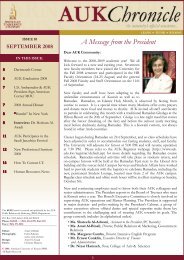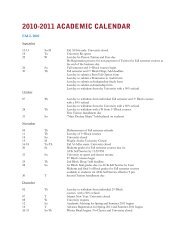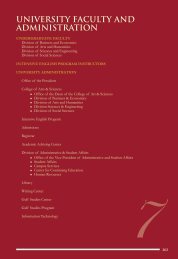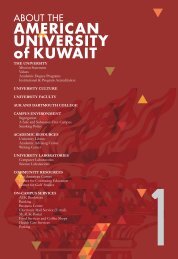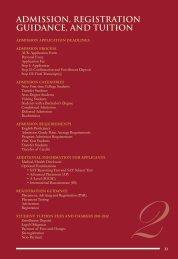EmotionalSignificant variations in academic success levels remain.Szulecka, Springett, and DePauw (1997) have suggestedthat the major causes of attrition of first year collegestudents are emotional rather than academic factors.Brooks and Dubois likewise found that emotional factorsexerted a strong influence on how well students adjusted totheir first year experience (1995). Leafgran (1989) suggeststhat students who are emotionally and socially healthyhave a greater chance to succeed in college. Pritchard andWilson (2003) found that student’s emotional health wassignificantly related to GPA regardless of gender. Thisis particularly important given the fact that recent studiesshow a dramatic increase in the levels of stress experiencedby college students over the last 30 years (Sax, 1997).While self-confidence, self-control, achievementorientation, perfectionism, and other personalityvariables have been found to be closely linked to collegeadjustment and retention, other personality variables aremore closely linked to attrition. For example, studentswho are more anxious are more likely to drop-out (Tobey,1997). However, the jury is still out on introversion andextraversion. While some studies find that introverts havethe highest retention rates (Spann, Newman, & Matthews,1991), others suggest that extraverts tend to adjust betterto college life (Searle & Ward, 1990) and perform higheracademically (Eysenck & Cookson, 1969; Irfani, 1978).The Pritchard and Wilson (2003) study on “UsingEmotional and Social Factors to Predict Student Success,”found that students who indicated their intent to drop outreported more fatigue and had lower self esteem thantheir peers. On the other hand, students who intended tostay in college used more positive coping skills and weremore likely to accept when they could not change thestressor. Pritchard and Wilson therefore suggest that “theability to deal successfully with the multitude of emotionalstresses encountered in college life appeared to be animportant factor in student retention” (p. 25). This is notnew information. In 1970, Harvard Professor W.G. Perryidentified the criticality of providing the optimum balanceof challenge and security at each new learning stage ina series on interviews with Harvard students. Perryexamined the relationship between task learning and largercontext about them, and the phases of development fromsimplistic thinking to mature commitment. Perry’s studyfound that if the threat of a new experience/learning is toooverwhelming, students cope with the anxiety by avoidingthe challenge (in Rickinson and Rutherford, 1995).How To Improve RetentionAccording to Parker (1997), the critical factors thatimprove retention include positive faculty relations,community relations, leadership, organizational services,orientation programs, student support classes andservices, recruitment planning, academic interventionservices, campus climate, and award programs (Parker,1997, para. 11). This is supported by Whitbourne (2002),who prioritized balancing socializing and studying,joining campus activities, seeking assistance and help,looking beyond financial issues to real problems social oracademic acclimation, remaining an “undecided” majorduring the first year of college, and seeking universitiesthat specifically focus on first generation and/or minoritystudent affairs (Whitbourne, 2002).In “New Approach to Curb Low-Retention Rates,” Powell(2003) identifies proven student retention techniques suchas the availability of tutors, midterm faculty evaluations,and an early warning system. In an effort to curb lowretention rates Alabama State University recentlyimplemented a writing across the curriculum program,and increased attention to student accountability measuressuch as class attendance and assignment completion.A 1996 study of 163 community colleges across the UnitedStates with enrollments of more than 5,000 studentsexamined strategies used to recruit, retain, and graduateminority students. The research indicated that studentsuccess is highest when retention efforts are coordinatedby a centralized office or person, making it visible andgiving it a sense of purpose (cited in Parker, 1997, para. 4).A number of authors call for mentoring programsto improve the institutions retentive power. Mentorprograms enable students to see successful studentsand staff, expose students to strategies for success, andprovide the confidence and support that some studentsneed to succeed. (Example: <strong>AUK</strong>’s new PALS program,a student peer tutoring and advising program.)Why They Work? Interaction And ConnectednessAttracting and recruiting incoming students is costly.Universities are working hard, therefore, to retain thestudent they have. One means of doing this is to ensurethat students feel connected to the institution and share asense of belonging to the university community.13
14In Astin’s (1997) article, “What Matters Most in Colleges:Four Critical Years” and later in his (1993) article, “WhatMatters Most in College: Four Critical Years Revisited,”he found that the retention of students is greatly affectedby the level and quality of their interactions with peers,faculty, and staff. Nutt (2003) in his article “AcademicAdvising and Student Retention and Persistence” alsoconcludes that retention can be highly affected byenhancing student interaction with campus personnel.The development of interpersonal relationships withpeers is critically important for student success (Upcraft,1982, 1985). Tinto (1987) found that “incongruence withone’s student peers proves to be a particularly importantelement in voluntary departure” (p. 57).Rendon (1995) found two critical factors in student’sdecisions to persist: (1) successfully making the transitionto college aided by initial and extended orientationand advisement programs and (2) making positiveconnections with college personnel during their first termof enrollment. Noel (1985) stated:“It is the people who come face to face with students on aregular basis who provide the positive growth experiencesfor students that enable them to identify their goals andtalents and learn how to put them to use. The caringattitude of college personnel is viewed as the most potentretention force on campus.” (p. 17)Student involvement in campus organizations also affectsstudent satisfaction (Cooper, Healy, and Simpson, 1994),drive to achieve, confidence in academic ability (House,2000), academic performance (Hartnett, 1965), anddecision to leave.Astin’s Student Involvement Theory (Astin, 1984) figuresprominently in the retention literature, suggesting that asstudents increase their physical and emotional investmenton their college campus (e.g., sports, clubs, campusactivities, involvement with faculty and staff), their rateof retention increases. (Note: These resulting associativerelationships may also explain the effectiveness of advisingrelationships and orientation programs.) Rickinson andRutherford (1995) identify several other models that aidin explaining the linkages between social adjustment andretention, to include:The Loss Model: separation anxiety can affect the abilityto make a new attachment.The Interruption Model: discontinuity in existing lifestyleand routines can raise anxiety.The Control Model: transition from a familiar to a newenvironment results in a period of loss of control.The Role-Change Model: anxiety of assuming a new roleand adjusting self-image.The Conflict Model: the security of home is balancedagainst the insecurity but also the challenge and interestof the new environment (Rickinson & Rutherford, 1995,para. 6).FacultySome of the most important implications revolve aroundrelationships with faculty. Astin (1993) suggests that nextto peer groups, “the faculty represents the most significantaspect of the student’s undergraduate development" (p.410). Studies of transfer students and freshmen studentsconfirmed the importance of faculty-student contact asan influential factor in student achievement, persistence,academic skill development, and personal development(Volkwein, King, & Terenzini, 1986; Pascarella &Terenzini, 1977).Faculty aid in retention in numerous ways. Researchdemonstrates that greater faculty-student interactionpromotes higher levels of student satisfaction with thecollege experience (Pace, 2001). A number of studentsstate or suggest that faculty participation and facultyinteraction is critical to student retention (Parker, 1999;Roach, 1999; and Tinto, 1989). Tinto (1987) emphasizesthe need for a connection to the institution if a studentis to be retained. Winston et al (1984) likewise identifyproactive faculty outreach as a significant part of thestudent’s decision to persist.According to Lau (2003), the use of collaborative andcooperative learning strategies, computer technology in theclassroom, computer laboratory experience, and teachingmethods that use mixed group techniques to foster criticalthinking and solve “real life,” “real business” problemsare critical to retention efforts. In addition, faculty inputand class contact with students has a profound influenceon student learning (Pascarrella and Terenzini, 1991).According to Lau (2003), faculty-student relationshipsand innovative teaching methods can significantlymotivate and challenge students to learn and stay inschool. Tinto (1987) found that students who are satisfiedwith the formal and informal academic and social systemsin a college or university tend to stay in school, whilethose with negative experiences become disillusionedand withdraw from family, friends, and the institution.
- Page 2 and 3: About AUK Occasional Papers:The AUK
- Page 4 and 5: higher education is distinguished b
- Page 6 and 7: The Impact of a Glass Ceilingon Wom
- Page 8 and 9: more women a chance to flourish in
- Page 10 and 11: consider other factors such as the
- Page 12 and 13: academically unprepared…you must
- Page 16 and 17: Advising and OrientationOther impor
- Page 18 and 19: etention. However, in addition, the
- Page 20 and 21: Hadi and Llabre (1998) assessed int
- Page 22 and 23: the event was encoded in parallel a
- Page 24 and 25: Public Health Impacts of Iraq’s 1
- Page 26 and 27: college work and have inadequate pr
- Page 28 and 29: memorization and repetition. This a
- Page 30 and 31: other in the pursuit of higher grad
- Page 32 and 33: for quality assurance, an organizat
- Page 34 and 35: RethinkingEntrepreneurship:Integrat
- Page 36 and 37: This type of training leads to enha
- Page 38 and 39: In short, Mount Allison students ha
- Page 40 and 41: Joplin, L. (1995). On defining expe
- Page 42 and 43: Figure 1. ExperientialEntrepreneurs
- Page 44 and 45: Kuwait - satellite television, cult
- Page 46 and 47: ReferencesAbt, V. & Seesholtz, M. (
- Page 48 and 49: interest in continuing to manipulat
- Page 50 and 51: Though corruption poses fundamental
- Page 52 and 53: A Cross-Cultural Modelof Innovation
- Page 54 and 55: were conceived as associations of c
- Page 56: others. In this case, confident pos
- Page 59 and 60: 58REFERENCESAmason, A. (1996) ‘Di
- Page 61 and 62: Shelton, C. and Darling, J. (2004)
- Page 63 and 64: 62• recycle natural resources use
- Page 65 and 66:
64Table Kuwait Fact Profile on Tran
- Page 67 and 68:
Table Transportation and Associated
- Page 69 and 70:
68• Third, each mode of transport
- Page 71 and 72:
70• Prepare a Bank Group transpor
- Page 73 and 74:
7219. Stratford,A. (1974). Airports
- Page 75 and 76:
74may be developed in a safe and or
- Page 77 and 78:
28. Tables - 1 Environmental Manage
- Page 79 and 80:
6) EnvironmentalAwarenessNo baselin
- Page 81 and 82:
80Iran, the US, and HighlyEnriched
- Page 83 and 84:
82since the 1951 nationalization of
- Page 85 and 86:
8450% of the population is astonish
- Page 87 and 88:
86The US also approved the Shah’s
- Page 89 and 90:
88George W. Bush’s State of the U
- Page 91 and 92:
90when Iran could not keep up with
- Page 93 and 94:
92rich states, the decrease of natu
- Page 95 and 96:
94indigenous training. Specifically
- Page 97 and 98:
96It is important to note that Russ
- Page 99 and 100:
Table 1: Nuclear Powered States and
- Page 101 and 102:
100Foucault, Michel. “What are th
- Page 103 and 104:
102Ramazani, Rouhollah K. “Iran
- Page 105 and 106:
104My SCORE, OurMATCH: CommunityPar
- Page 107 and 108:
106with a mate while he does mechan
- Page 109 and 110:
108dimensions of life including for
- Page 111 and 112:
correlated to the commitment and on
- Page 113 and 114:
REFERENCESBryce, J, Frigo, T, McKen
- Page 115 and 116:
GDP $21,300, GDP growth rate 6.8%,
- Page 117 and 118:
• Less than half of the people su
- Page 119 and 120:
118TABLE 4: # 1 Gulf Country in Eco
- Page 121 and 122:
120• More men than women indicate
- Page 123 and 124:
TABLE 8: Why? X GenderGENDERMALE FE
- Page 125 and 126:
TABLE 11: Success in improving Livi
- Page 127 and 128:
TABLE 14: Success in preserving Cul
- Page 129 and 130:
• Gender wise, more men felt that
- Page 131 and 132:
TABLE 18: How foreign workers are t
- Page 133 and 134:
• In terms of the preference of e
- Page 135 and 136:
TABLE 24: Should Oil be the Basis f
- Page 137 and 138:
F i gur e 18: S hould K uwa it J oi
- Page 139 and 140:
13811. What do you think about the
- Page 141 and 142:
140Conditions of Kuwaiti Dependence
- Page 143 and 144:
1422) if the alien has no means of
- Page 145 and 146:
144offered Mubarak recognition as a
- Page 147 and 148:
146labor regulations and enforcemen
- Page 149 and 150:
148intensifying suspicion and hosti
- Page 151 and 152:
150Commission on Freedom of the Pre
- Page 153 and 154:
Even the viceroy of India, Lord Cur
- Page 155:
Christine PiconeAustralian College



